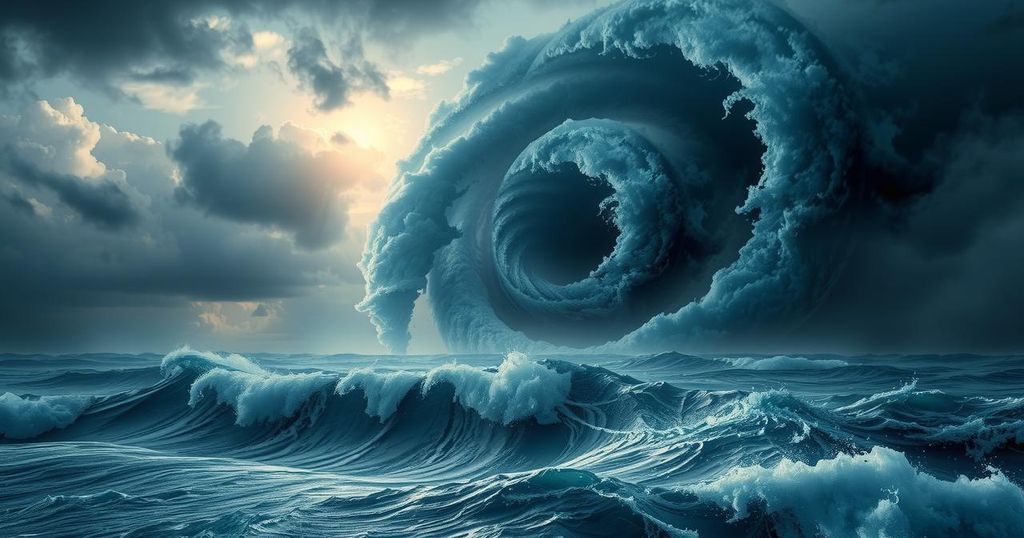Tropical Cyclone Zelia Approaches: What to Expect for Western Australia
Tropical Cyclone Zelia is set to impact the northwest coast of Australia, particularly Port Hedland. The Bureau of Meteorology warns of extremely dangerous winds up to 290 km/h. As a category five storm, it could cause widespread destruction, prompting discussions about a potential category six due to increasing storm intensity linked to climate change. Heavy rainfall and flooding are also anticipated as Zelia moves inland.
Severe Tropical Cyclone Zelia is approaching the northwest coast of Australia and is projected to make landfall early Friday evening. This massive storm raises concern for Western Australia, particularly Port Hedland, which is not only the largest town in the expected impact zone but also the busiest iron ore export port. Damaging winds may affect coastal and inland areas, like Marble Bar, Tom Price, and Paraburdoo.
Even if Cyclone Zelia does not make direct landfall on towns, it is anticipated to cause significant destruction. The Bureau of Meteorology forecasts extremely hazardous sustained winds of approximately 205 kilometers per hour, with gusts potentially reaching up to 290 kilometers per hour. Such wind speeds are capable of demolishing structures, uprooting trees, and damaging critical infrastructure.
This cyclone ranks as a category five, the highest level on the current grading scale for storm severity. As climate change leads to more extreme weather, some experts are advocating for the establishment of a category six to better portray the threat of these intense storms. Globally, tropical cyclones are referred to as hurricanes or typhoons, and they are classified from category one, the weakest, to category five, the strongest.
The current classification system ranges from category one, characterized by wind speeds of up to 88 kilometers per hour with minimal damage, to the extreme category five, which encompasses storms with wind speeds over 200 kilometers per hour and leads to widespread devastation. Recent studies indicate that as global temperatures continue to rise, cyclones are likely to become more potent.
Many scientists are calling for the addition of a sixth category to describe hurricanes, typhoons, and cyclones featuring sustained winds exceeding 309 kilometers per hour, highlighting the need for enhanced warnings regarding tropical cyclones exacerbated by climate change. Evidence connecting climate change to more intense tropical cyclones has been accumulating over the last three decades, culminating in research showing a correlation between global warming and heightened cyclone severity.
The year 2024 set records as Earth’s warmest year, with rising ocean heat content influencing regions that typically generate tropical cyclones. Warmer oceans and atmospheres provide additional energy, contributing to faster intensification of storms. Cyclone Zelia itself escalated from a category one to a category five within just 24 hours, which illustrates this growing concern.
Australia is currently facing unprecedented sea surface temperatures, with areas off the northwest coast observing increases between 4 to 5 degrees Celsius above seasonal averages. Hurricane Milton, which impacted the United States in October 2022, is an additional example of how climate change is worsening cyclone conditions, intensifying rapidly over warm ocean waters to achieve category five status.
The slow pace of Cyclone Zelia is particularly concerning, with a forward speed of merely 11 kilometers per hour, increasing the duration of dangerous conditions such as high winds and heavy rainfall. Tropical cyclones typically have their most destructive winds located near the eye but can extend hundreds of kilometers outward, creating devastating conditions in their path.
Currently, the wind speeds around Port Hedland range from 70 to 100 kilometers per hour, which is classified as gale force but not overly alarming yet. However, conditions are anticipated to rapidly deteriorate, particularly to the east of the town. The cyclone has already resulted in substantial rainfall, causing localized flooding and disruptions to rail services, with more significant impacts on the horizon.
The Bureau of Meteorology has issued warnings regarding a considerable storm tide, which can cause sea levels to rise above average high tide, leading to flooding of coastal infrastructure. Cyclone Zelia is expected to move inland over the weekend, diminishing in strength but still affecting communities far from the coast with intensified winds and rainfall.
In summary, Tropical Cyclone Zelia poses a significant threat to Western Australia, particularly Port Hedland and surrounding areas. With forecasts indicating dangerously high winds and the potential for extensive damage, authorities emphasize the importance of preparedness. Climate change remains a pressing issue, as it increases the frequency and intensity of such storms, necessitating discussions about updating the classification system to include a sixth category for severe cyclones.
Original Source: theconversation.com




Post Comment